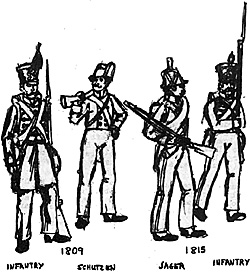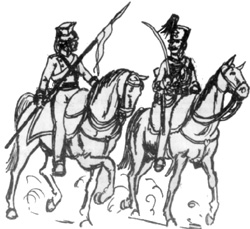Brunswick Contingents Part I: American Revolution
 1809 Austrian Service
1809 Austrian Service
In February of 1809, Duke Ferdinand Wilhelm of Brunswick-Luneburg and Oels made a contract with the Austrian Government to provide an independent Brunswick contingent for Austrian Service against Napoleon. The Duke was bound to raise and maintain at his own expense, a regiment of infantry and a Regiment of Hussars each with a strength of 1,000 men. The Infantry regiment would contain 4 companies and the Hussars would have a strength of 4 squadrons with attached artillery consisting of two 7lb. howitzers and two 6lb.cannons.
The corps were assembled in Oels near Nachod in Apr 1 of 1809. They were designated as the 92nd Brunswick infantry regiment, the 17th Brunswick Hussar Regiment, and the 5th Brunswick Battery of the 10th Scharnhorst Field Artillery Regiment. When the march to Northern Germany began (July 24), the corps consisted of 2010 men and 100 officers organized as follows:
- Chief of Staff: Col. W. Von Donberg
Deputy : Major Korfes
Inf. Brigade C.0.: Col. You Bernewitz
lst Battallion Major V. Fragetein 500 man (4 coys.)
2nd Battallion Major V. Reichmeister 560 men (4 coys.)
3rd Battallion. Major V. Herzberg 150 men ( 1 coy.)
Sharpshooter Coy. Major V. Schreever 150 men (4 sqds.)
Hussar Regiment Major Schrader 550 men
Uhlan Squadron Count V. Weddell 80 men
Artillery Lt. Gederer 80 men
Utilizing Vietmeyer's 20/1 ratio for Colun, Line, and Square, rules the wargame organization is as follows:
- 1st & 2nd Btn.
- OOO OOO OOO OOO
OOO OOO OOO OOO
3rd Btn. & Sharpshooters
- OO OO OO OO
Hussars
- OOO OOO OOO OOO
OOO OOO OOO OOO
Hussars
- OO OO
Uniforms
I&II Infantry Battalion
Knee length black tunic with light blue collar and cuffs, no epaulettes, 7 black cords On front, light blue stripe on pants, Black shako with horse hair p1ume, white skull and crossbones insignia.
Officers the same with silver shako plate and red sash with tassels.
Non-commissioned officers had a red dash with a light blue stripe. Drummers had white lace on the wings of the coat. Drums were brans with yellow and blue hoofs. All belting in black, black knapsack, blue British style canteen and unbleached linen haversack.
III Battalion
An above except that they wore short waistcoat & with yellow facings. Officers had gold braid epaulettes (aiguillette) on right shoulder.
Sharpshooters
These wore a uniform similar to the Prussian Jager except that the had was like that of the Tyrolean Jager with green band and border. Dark green coatee with red collar and cuffs, 2 rows of brass buttons; light grey trousers, black spate and shoes; Powder horn hanging from left shoulder on a green cord. Large black leather hunting pouch hung from right shoulder with large black strap. Officers wore green coat with gold epaulettes (aiguillete) and same pants an infantry officers.
 Hussars
Hussars
The Hussars wore the same pants as infantry with yellow, a black dolman braided black, light blue collar and cuff (no braid on collar), black trousers with blue piping, black sabertache with blue border. The hussar sash of yellow barrels with light blue knots.
Trumpeters wore gold braid on musicians wings, the trumpet cords being yellow and light blue.
Officers hussar sash was of yellow barrels with silver knots. Sabertache the same as for enlisted men except for silver death's head insignia.
Horse furnishings were of black leather with brass buckles, blanket of black lamb fur with a light blue border.
 Artillery
Artillery
Black coatee with black cords. Light blue collar, shoulder straps, cuffs, and tall turn-backs. Equipment and horse furnishings as for Hussars.
Uhlans
Similar to Austrian Uhlans: Dark green jacket; and overalls, red collar, pointed cuffs, piping, and turnbacks. Red band on side of overalls, red shoulder straps. Lancer cap with yellow top, (Officers with red piping and gold buttons on overalls. Skull and crossbones on lower part of of cap, yellow plume and gold epaulettes. Green pointed shabraque with red border, green valise with red lace. Lance penons are given both as yellow and red or yellow and blue.
1809 British Service in the Peninsula
1. All three light battalions bad the Game uniform as the 1st Battalion under Austrian Service.
2. Sharpshootere were disbanded
3. Uhlans and artillery were incorporated into the Hussar regiment, which continued to wear the same uniform as in Austrian service.
1812-1815
Line Infantry
Men: Short black jacket without tails, black pants and, shoes. Black shako with white metal badge and pear shaped pompom, yellow with upper third light blue. English model canteen of light blue. Crossed belts, cartridge pouches haversacks, rifle slings, etc., are black. The distinctions between battalions was made by the color of the collar, shoulder bands, jacket cuffs, and pants stripe: 1st Battalion: Red, 2nd Battalion: Green, 3rd Battalion: White.
Sergeants: Same as above with yellow waist sash, silver chevrons.
Drummer: Same as above but with pompom colors reversed. Swallow nests of battalion distinction color (swallow nests are large epaulettes which cover the upper part of the arm. Drum was brass with yellow and light blue striped hoops and black belting.
Officers as above, pompom colors reversed. Waist sash yellow twined with silver. Gloves green.
Light Infantry
The light infantry was the same as the line except for having a silver colored German Horn an a shako badge and black jacket cuffs.
- 1st Battalion: Buff
2nd Battalion: Yellow
3rd Battalion: Orange
Lieb Battalion
The Lieb Battalion wore the horsehair plume and the skull and crossbones, shako plate. Otherwise the uniform was the same as for the line.
Avant-Garde Battalion
Was made up of Jaegers and Light Company troops who were returning from English service during the peninsular wars. The Light Companies probably had the same uniforms as during the 1809 period, Polrocks and horsehair, plumes, etc. From the painting "Death of the Duke of Brunswick," it would seem that the Jaegers of the Avant-Garde Battalion were made up of representatives of both the English service sharpshooters and Jaegers (III Battalion). The Jaegers were in black coats with yellow trim and black tyrol type hats without plume turned up on the right hand side. The sharpshooters were in dark grey with green collar and cuffs and grey tyrolean hats with green plume, turned up on the left aide. The foregoing assumptions and deductions are furthur fortified by Knoetel. I would welcome information from the readers in this area.
Artillery
According to Knoetel, the foot artillery had black uniforms identical to the line infantry but with yellow facings and an all yellow pompom, on the shako. The shako plate was a shell. Horse artillery as above with black horsetail plume and Deathshead shako plate.
Uhlans
Black short coat and pants with light blue plastron, collars, cuffs, and pants stripe. The plumeless, tachapka had a light blue top. Horse furnishings were black. A black blanket with light blue trim covered the saddle. The lance flag was yellow and blue.
Hussars
The hussars wore the same uniform an the line infantry except for a deathshead shako Plate, light blue collar and cuffs, light blue piping on black trousers, yellow hussar sash with light blue knots and a black shabraque with blue border. Officers had deathshead on the shabraque and silver piping on the trousers. Trumpeters had gold laced swallow nests. Blanket pattern was the same as for the uhlans.
More Brunswick Contingents
-
Brunswick Contingents Part I: American Revolution
Brunswick Contingents Part II: Napoleonic Era 1809-1815
Brunswick Contingents Part III: Flags at Waterloo 1815
Back to The Armchair General Vol. 2 No. 6 Table of Contents
Back to The Armchair General List of Issues
Back to MagWeb Master Magazine List
© Copyright 1970 by Pat Condray
This article appears in MagWeb (Magazine Web) on the Internet World Wide Web. Other military history articles and gaming articles are available at http://www.magweb.com
